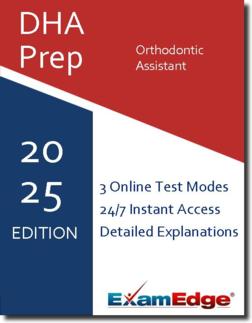DHA Orthodontic Assistant (DHA-OA) Practice Tests & Test Prep - Topics
Based on 37 Reviews
- Real Exam Simulation: Timed questions and matching content build comfort for your DHA Orthodontic Assistant test day.
- Instant, 24/7 Access: Web-based DHA Orthodontic Assistant practice exams with no software needed.
- Clear Explanations: Step-by-step answers and explanations for your DHA exam to strengthen understanding.
- Boosted Confidence: Reduces anxiety and improves test-taking skills to ace your DHA Orthodontic Assistant (DHA-OA).

Understanding the exact breakdown of the DHA Orthodontic Assistant test will help you know what to expect and how to most effectively prepare. The DHA Orthodontic Assistant has multiple-choice questions The exam will be broken down into the sections below:
| DHA Orthodontic Assistant Exam Blueprint | ||
|---|---|---|
| Domain Name | % | Number of Questions |
| ICE - Infection Control | ||
| Patient and dental healthcare worker education | 10% | 5 |
| Prevent cross-contamination and disease transmission | 20% | 10 |
| Maintain aseptic conditions | 10% | 5 |
| Perform sterilization procedures | 15% | 7 |
| Environmental asepsis | 15% | 7 |
| Occupational safety | 30% | 14 |
| OA - Orthodontic Assisting | ||
| Collection And Recording Of Clinical Data | 15% | 7 |
| Orthodontic Procedures | 36% | 17 |
| Chairside Dental Materials | 37% | 18 |
| Laboratory Materials And Procedures | 5% | 2 |
| Oral Health Management Prevention And Management Of Emergencies | 5% | 2 |
| Office Operations | 5% | 2 |
| Radiation Health And Safety | 5% | 2 |


